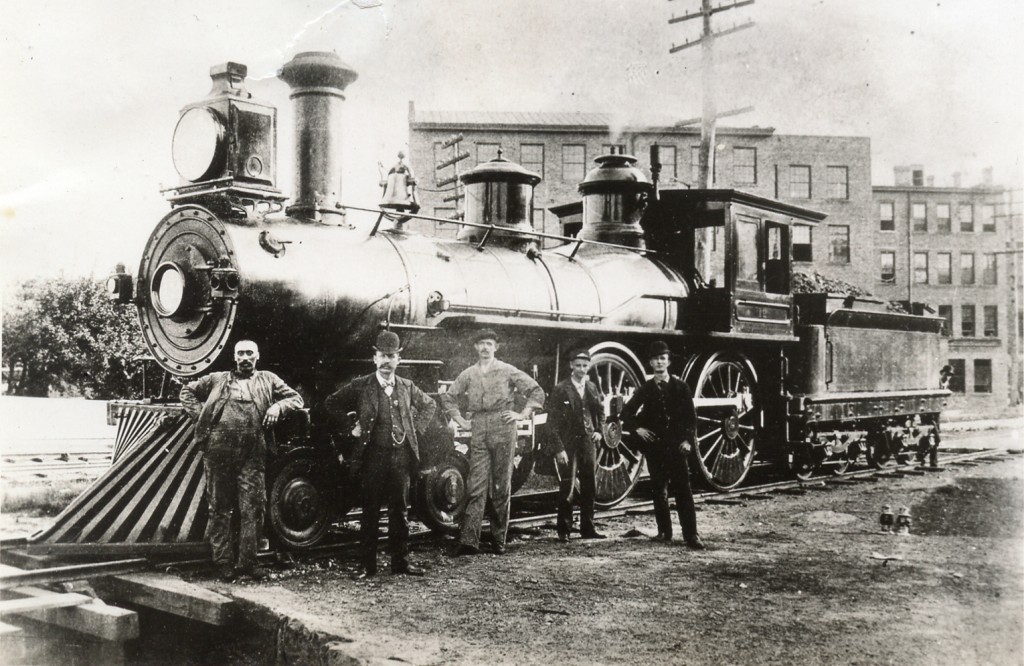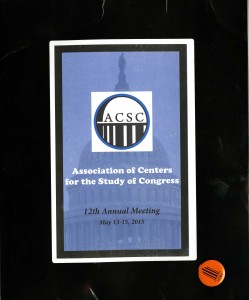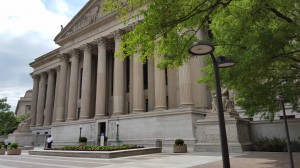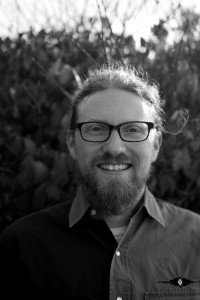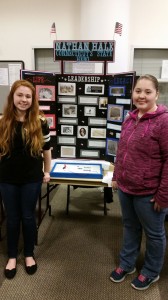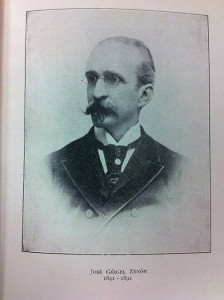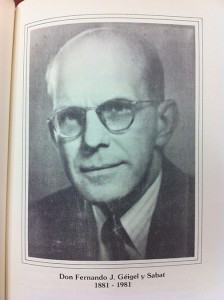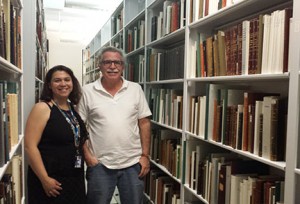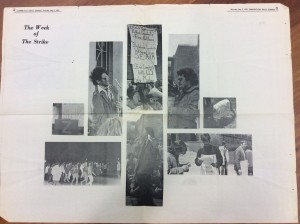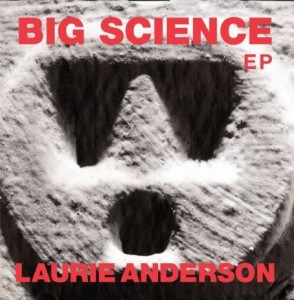We enjoyed reading a May 23 letter to the editor, “History and Safety on the Railroad,” in the New York Times by our railroad friend, supporter and donor J.W. (Jack) Swanberg, where he explains that historically the railroads in the United States have had to build their own stations and right-of-way without any kind of public support, unlike public roads and the airline industry. Jack certainly writes from his own personal knowledge of railroad history, as the author of New Haven Power, a history of the New York, New Haven & Hartford Railroad’s engines and other motive power, and numerous articles in railroad magazines on a myriad of railroad history topics.
Yearly Archives: 2015
12th Annual Conference of the Association of Centers for the Study of Congress (ACSC)
Archives & Special Collections is a founding member of the Association of Centers for the Study of Congress, an organization which encourages the preservation of material that documents the work of Congress, including the papers of representatives and senators, and supports programs that make those materials available for educational and research use. Last week I attended the 12th annual meeting of ACSC, hosted by the National Archives and Records Administration’s Center for Legislative Archives located in Washington, D.C.
Over the years I have been representing UConn in this organization, I have taken the opportunity of the location to meet with the staff of Connecticut’s Congressional delegation and this year was no exception. On May 12th, I met with the Chief/Deputy Chief of Staff for Representatives Larson and Esty and Senators Murphy and Blumenthal to remind them that UConn would be interested in being identified as a repository for their papers and to answer any questions they may have regarding congressional research collections or Archives & Special Collections at UConn. Having already spoken with representatives of Rosa DeLauro and Joe Courtney earlier in the year, I hope to hear from all of them when the time comes for the records to find a permanent home!
The conference itself is a great opportunity to meet with colleagues from repositories with similar collecting interests and to learn what is happening in the wider world of documenting Congress, as well as hear from scholars and former members about their concerns, interests and activities associated with congressional papers. Sessions throughout the remainder of the week touched on think tanks, instruction support tools for the Bill of Rights, financial and friend support, women in Congress in the 1980s, electronic records and current research, and oral histories with a focus on the Voting Rights Act. Rounding out the two and half day conference was a presentation by a small group of ACSC members who have begun a collaborative online exhibition, an online Omeka instance hosted by the University of Delaware, that shares items from a variety of institutions illustrating issues associated with the 89th Congress (1965-1966). Definitely a project to which UConn will be contributing! It was also a pleasant surprise to have our own Barbara Kennelly, who served in Congress for 17 years representing the 1st District, speaking as part of the women in Congress presentation. This annual conference is always informative and sends one home bursting with ideas and plans…but having been away from the office for a week, I have some catching up to do first.
For more information about
The Association of Centers for the Study of Congress
The political collections in Archives & Special Collections
The Great Society Congress online exhibition
Congress creates the Bill of Rights information (app/ebook/pdf)
Barbara Kennelly Papers
Senate Oral histories
Archivist Graham Stinnett featured on Queer!NEA
I believe in the principles of archives as tools for engagement with a broader societal understanding of itself and how it can be leveraged for change in society, so building on these collecting areas is very beneficial. We are always being documented, it is our job to engage the creation of memory from that documentation.
Check out the latest post on Queer!NEA, a blog for New England Archivists’ Lesbian, Gay, Bisexual, Transgender and Queer Issues Roundtable, featuring an interview with our very own Graham Stinnett, Archivist for Human Rights and Alternative Press Collections. Graham tells us about his professional interests and the array of activities that occupy his days here at UConn with students and faculty. He also reflects on the critical, tangible value of archives today “to promote the dialectic between the then and now”…
When considering the basis of text communication in social media platforms today which could be the closest comparison to the channels of alternative press, these outlets have more in common than they do in division. My goal is to promote the dialectic between then and now. Beyond the narrative that all movements toward rights are valuable and worth documenting, my interest has been to promote the intersections where students have made impacts through documentation in the past which now can inform the present context of identity, recreation, sociability and agency. Having said all that, I don’t think we as archivists have yet understood how to deal with today’s alternative press, which is why these conversations are so important.
Winners of the Archives & Special Collections prize for Connecticut History Day
Congratulations to Victoria Farrell and Kayla Gobar of New Britain High School, winners of the Archives & Special Collections of the UConn Libraries special prize for projects on Connecticut Leaders and Leadership, which they won at the May 9, 2015, Connecticut History Day contest held at Central Connecticut State University. The girls won the prize for their project “Nathan Hale: Connecticut’s State Hero.” We are very happy such an interesting topic was awarded the prize, which is a gift certificate to the UConn Bookstore.
The Geigel at the Archives: A look at the Géigel Family’s impact in documenting Puerto Rican socioeconomic and cultural history through the Puerto Rican Collection
[slideshow_deploy id=’5552′]
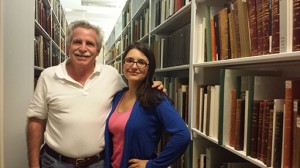
Luis Géigel and his daughter, Bianca Géigel Lonergan in the stacks where part of the Puerto Rican collection is located (06/18/2014).
Last June 18, 2014 I had the pleasure to welcome to the archives two family members of the late Luisa Géigel—the last owner of what it is known as the Puerto Rican Collection, A.K.A. the Geigel Family Collection. Bianca Géigel Lonergan contacted me in June to see if we could arrange a visit to the collection so her father, Luis Géigel, could see the books her cousin (*), Luisa Geigel de Gandia sold to the archives. For the visit I gathered a selection of the books published by several members of the Géigel family in the collection as a way to reflect on the importance of this family in the development of Puerto Rico as a modern nation since the late 19th century.
As I mentioned in previous blog postings about this collection (2010 and 2012), the Archives and the Special Collections department, with the help of a former UConn History professor Francisco Scarano, acquired this collection in 1982 through several grants and financial supports from the Research Foundation, the College of Liberal Arts and Sciences, the Center of Latin American Studies, the Class of ’26, and the University of Connecticut Foundation, from Luisa Géigel de Gandia. Luisa Géigel de Gandia was an important artist in Puerto Rico especially in the 1940s. She was the first Puerto Rican female sculptor. She also was a painter and was the first women artist to exhibit several nude figure studies in Puerto Rico. She was a co-founder, together with Nilita Vientos Gastón, of the Arts Division at the Ateneo Puertorriqueño. From 1958-1986 she taught Sculpture, Drawing and Artistic Anatomy at the University of Puerto Rico, Río Piedras Campus. She was also a published author.
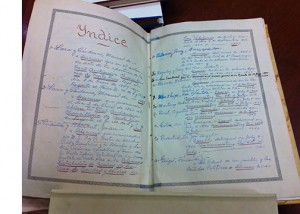
Index and inventory created by Luisa Géigel of the titles and location of all the books in the Géigel collection in her home in San Juan, PR
Together with her father and grandfather, she maintained, expanded and inventoried her family’s books and serials collection. As Dr. Scarano aptly described it, “this magnificent research collection, painstakingly nurtured by the Géigel family of San Juan for three generations, constitutes a bibliographic resource of national scholarly significance” (1).
From rare literature gems from the 19th century and 20th century to agricultural and political treatises, this collection serves as a snapshot of the different cultural, political, scientific, and economic movements experimented in Puerto Rico in the past two centuries. The collection also reflected the various interests that drove the family members, José Géigel y Zenón (1841-1892), Fernando Géigel y Sabat (1881-1981), y Luisa Géigel de Gandia (1916-2008) to amassed this collection. Other individuals that donated materials to the original collection was Ramón Gandia Córdova, Luisa Géigel’s father-in-law who donated a good portion of the agricultural books found in this collection. There are other members of the Géigel family represented in the collection such as Vicente Géigel y Polanco (politician and former president of the Ateneo Puertorriqueño), A.D. Géigel (a translator of foreign novels during the 19th century), and Luis M. Géigel (agronomist and father and grandfather of our visitors).
The Geigel family members were great contributors to the cultural and political life of Puerto Rico and their work reflected their deep love and concerns about the past, present and future of Puerto Rico. José Géigel y Zenón, known as Pepe by his contemporaries, was part of the intellectual elite in 19th century Puerto Rico and was friend and/or relative to many important cultural figures such as Alejandro Tapia y Rivera and Manuel Zeno Gandia—who signed and dedicated their books to their dear friend Pepe. In term of cultural contributions, José Géigel y Zenón, together with Abelardo Morales Ferrer wrote one of the most definite Puerto Rican bibliography of their time titled, Bibliografía Puertorriqueña 1492-1894 which was produced between 1892 -1894. Later on his son, Fernando Géigel y Sabat published the first edition of this work in 1934. In addition, Fernando published a compilation of his father satirical writing that he published in different 19th century newspapers such as El Progreso, Don Simplicio, El Derecho, y La Azucena, titled, Artículos político-humoristico y literarios por Jose Géigel y Zenón (1936).
Fernando Géigel y Sabat was also an important member of the family. A lawyer by training, he was a Manager of the City of San Juan (1939–1941) and published author. He authored several books which range from political topics such as El ideal de un pueblo y los partidos politicos (1940) to historical treatise, Balduino Enrico (1934), and Corsarios y piratas de Puerto Rico 1819-1825 (1946)—inspired in part by Alejandro Tapia y Rivera novel, Cofresí, which Tapia dedicated to Fernando’s father. Also present in the collection are several important titles from Vicente Géigel y Polanco. A politician, reporter, essayist, ateneísta, he was a pivotal figure in Puerto Rico during the mid-20th century. The collection has several of his books such as El problema universitario, on the role of the university in Puerto Rican culture, La independencia de Puerto Rico about independence as a political option for Puerto Rico, and his memoir about his work at the Ateneo Puertorriqueño, Mis recuerdos del Ateneo.
There are two books from Luisa Géigel in the collection, La genealogía y el apellido de Campeche and El paquete rojo o informe sobre la extinción de la moneda Macuquina. Luis M. Géigel’s work at the Estación Experiemental in Puerto Rico is also present with the title, El algodón “sea-island” en Puerto-Rico which is available at the Internet Archives. I have compiled a list with the books published by the Geigel family in the collection for your enjoyment.
This visit by Bianca and Luis Géigel was quite a walk into memory lane. It helped me to contextualize this collection as part of a bigger project of imaging Puerto Rico as part of a broader cosmopolitan project that connected Puerto Rico with its past, present and possible futures. The vision of the Géigel family for Puerto Rico was multifaceted and its collection represented that diversity of thoughts, history, politics and cultural projects experimented during the 19th and 20th century. Walking with Luis and Bianca into the stacks at the Archives and Special Collections to see the books up close and personal, was like embarking in a time-traveling adventure similar to the ones imaged by the Alejandro Tapia y Rivera in one his stories; a type of magic only find in the archives…
Note: (*): Luis Géigel is Luisa’s first cousin once removed.
References:
Scarano, Francisco A. “The Géigel Puerto Rican Collection”. Harvest. The University of Connecticut Library, Fall 1982: 1-2.
Biographical Data for Luisa Géigel available at these sites:
- Conoce la vida y obra de Luisa Géigel Brunet
- Enciclopedia de Puerto Rico en Línea: Luisa Géigel
Independent Voices Now Accessible
A large archive of digital Alternative Press newspapers is now available to UConn students, faculty and staff.
Independent Voices is a digital collection made up of alternative press newspapers, magazines and journals from the latter half of the 20th century, drawn from the special collections of participating libraries. Archives and Special Collections has been contributing materials from its holdings to the digital archive over the last year. These periodicals were produced by feminists, dissident GIs, campus radicals and the New Left, Native Americans, anti-war activists, Black Power advocates, Hispanics, LGBT activists, the extreme right-wing press and alternative literary magazines.
This is a valuable resource for research comprised of what is an increasingly deteriorating paper medium for historically alternative politics and culture In America. Independent Voices can be found in the Human Rights databases through the library webpage.
Kent State and Student Strike at UConn
In 1968 students at UConn demonstrated against the ROTC and military recruiting on campus as national uprisings began to foment against the war in Vietnam. Corporate job recruiting by General Electric and Olin Mathieson on Gilbert Rd. drew confrontations between protestors and state police along with President Homer D. Babbidge’s approach toward a business friendly posture for the university. The combative times of the UConn Crisis in 1968-1969 was the prologue to an even more eruptive year to come. Lyndon Johnson’s escalation of the war led to major backlash in the mid to late 1960s which President Nixon’s administration promised to diminish by quietly widening military campaigns into neighboring Cambodia.
Student demonstrations in over 1,250 college campuses across the country led to confrontations with local police and the national guard. On May 4th, 1970 protests at Kent State University in Ohio led to National Guardsmen firing into demonstrators killing four individuals and wounding several others. The events of 1970 galvanized much of the public’s perception on the war in Vietnam however clashes at home along class and race lines similarly disrupted any clear consensus about the war at home and abroad. The days following the Kent State shootings on the University of Connecticut campus would produce the actions of students, faculty and administration which declared 1970 as the high water mark for social upheaval. The events below were extracted from the extensive archive documented by student organizations, administration and the Daily Campus: Continue reading
Laurie Anderson’s Big Science: Gender, Automation, and Created Beings
“O Superman. O judge. O Mom and Dad. Mom and Dad,” begins performance artist Laurie Anderson’s “O Superman.” Half-sung, half-spoken, and captivatingly hypnotic, the eight-minute song featured on Anderson’s 1982 album Big Science reached number two on the U.K. charts in the early 1980s.
Anderson’s work strikes an interesting balance between abstraction and accessibility. Despite the popularity of “O Superman” and the rest of Big Science, Anderson encodes her work with rich references to literary texts, operas, cultural trends and pop culture events. The album most extensively engages with the relationship among communication, technology, and political affairs. “Big Science,” after all, is a term used to describe the shift during and after World War II toward government-funded, large-scale scientific projects principally devoted to the development of new weapons and tools.
Furthering her engagement with technology are the instruments and techniques Anderson uses to produce her music. The spoken text of “O Superman,” for example, is dictated through a vocoder, a synthesizer used to reproduce human speech. Anderson uses the technology to make her voice sound synthetic, therefore mimicking the automatic voice of an answering machine and blurring the assumed boundaries between the natural and the artificial. But the most fascinating aspect of Anderson’s performance art is both its timeliness and timelessness—her songs are just as topically relevant and profound today as they were over thirty years ago.
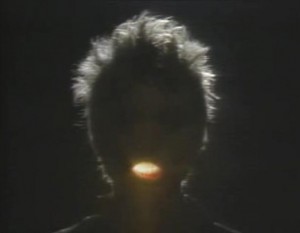 I had the opportunity to listen to Anderson’s vinyl LP using the Dodd Center’s electronic equipment. I’ve compiled the digitized tracks of Anderson’s Big Science here for those interested in listening at home.
I had the opportunity to listen to Anderson’s vinyl LP using the Dodd Center’s electronic equipment. I’ve compiled the digitized tracks of Anderson’s Big Science here for those interested in listening at home.
-Giorgina Paiella
Intern Giorgina Paiella is an undergraduate student majoring in English and minoring in philosophy and women’s, gender, and sexuality studies. In her new blog series, “Man, Woman, Machine: Gender, Automation, and Created Beings,” she explores treatments of created and automated beings in historical texts and archival materials from Archives and Special Collections.
Earth Day 2015: Wild Beauty Through the Lens of Edwin Way Teale
[slideshow_deploy id=’5502′]
The long fight to save wild beauty represents democracy at its best. It requires citizens to practice the hardest of virtues – self-restraint. Why cannot I take as many trout as I want from a stream? Why cannot I bring home from the woods a rare wildflower? Because if I do, everybody in this democracy should be able to do the same. My act will be multiplied endlessly. To provide protection for wildlife and wild beauty, everyone has to deny himself proportionately. Special privilege and conservation are ever at odds.
Edwin Way Teale, Pulitzer Prize-winning author and naturalist, spent his life observing and recording his vivid experiences in, and encounters with, the natural world. We honor Teale and his legacy this Earth Day 2015 with a selection of photographs from his rich archive being preserved here at UConn. The excerpt is from Teale’s 1953 book Circle of the Seasons. The pictures were selected by Kristin Eshelman, Archivist for Multimedia Collections in Archives and Special Collections.
A Language of Song: Samuel Charters Remembers John Fahey and the Fahey Style
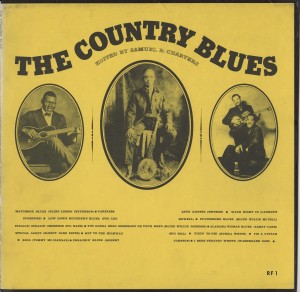 Within the archive of books, recordings, sheet music, letters, audiovisual materials, and advertising materials assembled by Samuel Charters are the compositions and recordings produced by contemporary blues-based musicians including John Fahey. Rare recordings released on Fahey and Ed Denson’s independent record label Takoma Records, dating from the founding of the record label in 1959, together with Fahey’s later releases, reside in Series IIB of the Samuel and Ann Charters Archives of Blues and Vernacular African American Musical Culture. Here, Samuel Charters remembers his first encounter with John Fahey and later, with his instrumental and compositional style:
Within the archive of books, recordings, sheet music, letters, audiovisual materials, and advertising materials assembled by Samuel Charters are the compositions and recordings produced by contemporary blues-based musicians including John Fahey. Rare recordings released on Fahey and Ed Denson’s independent record label Takoma Records, dating from the founding of the record label in 1959, together with Fahey’s later releases, reside in Series IIB of the Samuel and Ann Charters Archives of Blues and Vernacular African American Musical Culture. Here, Samuel Charters remembers his first encounter with John Fahey and later, with his instrumental and compositional style:
In the summer of 1959 an LP came in the mail to the basement apartment in Brooklyn where I had just finished writing The Country Blues. The record was in a white cover, with only the words “Blind Joe Death” in large letters on both sides. With it there was a letter to me from someone named John Fahey, telling me that this was a record he had made of his own music, and asking me for an opinion. The letter was as guarded as the LP jacket. The music was a series of guitar instrumentals based on the finger picking style of the Mississippi bluesmen. I kept waiting for someone to sing, and when I didn’t hear any singing I wrote John a short note saying that other people in New York were doing
the same kind of thing but the record was interesting. John has never forgiven me for my note, and even if I’m not sure if we ever would really have become friends I have always been angry at myself for my insensitivity. John sent out a few copies of the record, which he had pressed for himself on his own Takoma label, and sold more through mail orders.
When the copies were gone he recorded a new record and sold the copies the same way. This time the copies went more quickly, and he recorded a third album. Within a few years Fahey and his music had become one of the growing influences of the 1960s. He was still almost unknown personally, but his music was everywhere in the new underground.
I had difficulty describing the pieces when I first heard the 1959 album, but I soon realized that John had created a new music, based entirely on the materials he had learned from the country blues. He had been one of the people who rediscovered Bukka White, and then Mississippi John Hurt, and from the musicians themselves he had absorbed finger techniques and new concepts of guitar tunings and chordal structures. He has never described himself as a guitarist – his description of his own music is that he is a composer who plays the guitar. What he did was to create a compositional style which synthesized elements from the entire range of rural southern string music, including the Mississippi slide guitar, Virginia string bands, the alternate thumb picking of the Delta, and the finger style of the Carolinas. His compositional technique was to record passages with different guitars which built up segments of his pieces – then he spliced the tape sections together, editing, changing tone, and adding echo effects. His last step was then to learn the piece as it was finally structured so he could perform it.
By the middle of the ‘60s John was touring regularly, and he had outgrown the small record company he had set up with a partner, ED Denson, the man who had gone to Memphis with him to find Bukka White. I had known ED for several years and we worked together to sign John to a contract with Vanguard. There were two albums – the first an album that included three long requia, and an extended three part piece that utilized a complicated sound montage over John’s guitar. We recorded many of the sound effects for the montage at Knott’s Berry Farm outside of Los Angeles, where the events John was depicting in the composition had taken place. Because of time problems and delays from John’s side I finally went ahead and mixed the sound piece without him, and our edgy relationship became even more difficult.
For the second album on the Vanguard contract he worked with a friend, Barry Hansen, in Los Angeles, while I acted as executive producer in New York. The album, The Yellow Princess, was one of John’s finest achievments, with a music concrete piece built on montage, a successful fusion of his guitar with small instrumental groups, and a rich collection of new compositions.
By this time Fahey had a series of disciples, among them Leo Kottke, who developed the idiom John had created into a more flamboyant and emotionally open statement. John was not upset. He recorded Kottke for his own record company, and they continued to be close friends. He was also having emotional problems, and his life often veered into difficulties, despite the growing creativity of his music. By the 1970s an entire school of guitar composition had grown from his work, and a new record company, Windham Hill, was established by a guitarist named Will Ackerman to present young guitarists playing in the Fahey style. It isn’t an exaggeration to say that John’s guitar compositions were the basis for the New Age movement that swept the guitar world, and that the basic foundation for all of it was southern blues guitar.
The series A Language of Song features the words of Samuel Charters and the recordings he produced as preserved in The Samuel and Ann Charters Archives of Blues and Vernacular African American Musical Culture at the University of Connecticut. The series is a tribute to the great Samuel Charters – poet, novelist, translator of Swedish poets, and renowned scholar of the blues, jazz, and musical culture of the African diaspora. Samuel Charters died on March 18 at the age of 85.
Tomorrow: Fred Ho Fellow Marie Incontrera Performs with the Eco-Music Big Band
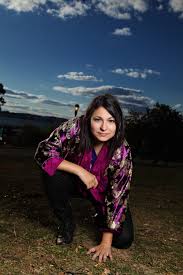 UConn welcomes Marie Incontrera – conductor and band-leader of the Green Monster Big Band (Fred Ho’s premiere big band) and the Eco-Music Band – to campus tomorrow April 14 at 12:45pm for a public performance. The Eco-Music Big Band is a 15-piece, multi-generational big band that is committed to continuing the prodigious compositional and creative legacy of Fred Ho. The ensemble also performs the works of the overlooked composers of 20th century (such as Cal Massey), and provides a platform for the next generation of big band composers.
UConn welcomes Marie Incontrera – conductor and band-leader of the Green Monster Big Band (Fred Ho’s premiere big band) and the Eco-Music Band – to campus tomorrow April 14 at 12:45pm for a public performance. The Eco-Music Big Band is a 15-piece, multi-generational big band that is committed to continuing the prodigious compositional and creative legacy of Fred Ho. The ensemble also performs the works of the overlooked composers of 20th century (such as Cal Massey), and provides a platform for the next generation of big band composers.
Ms. Incontrera has been awarded the 2015 Fred Ho Fellowship, named for Asian American Musician, composer, writer and activist Fred Ho. Established by the Asian and Asian American Studies Institute, the Fred Ho Fellowship supports research in the Fred Ho Papers, which are held in Archives and Special Collections at UConn.
Fred Ho’s conducting protégé before his death in April of 2014, Marie Incontrera conducted the Green Monster Big Band for Fred Ho’s final album.
Ms. Incontrera’s work spans queer opera, political big band, and music-for-the-oppressed. As a composer, Marie has been a recipient of the Miriam Gideon Composition Award, a winner of 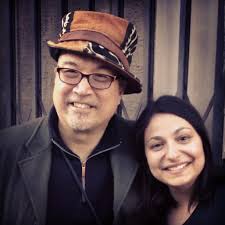 the Remarkable Theater Brigade Art Song Competition, the 2011 Vocalessence / American Composers Forum “Essentially Choral” readings, and a finalist in the Iron Composer 2010 competition. She has been awarded grants from Meet the Composer Metlife Creative Connections, Foundation for the Contemporary Arts, Puffin, and New York Women Composers Seed Money Grant. Commissions have come from the Young New Yorkers Chorus, Remarkable Theater Brigade, ANALOGarts, Brooklyn Art Song Society, ANIKAI Dance Theater, MOIRAE Ensemble, Beth Morrison Productions, and Atlanta Opera. Her work has been performed in Carnegie Hall, Symphony Space, Brooklyn Academy of Music, the Meridian Arts Festival in Bucharest, Roulette, Galapagos Art Space, WOW Cafe Theatre, highSCORE Festival, and other respected venues across the United States and internationally.
the Remarkable Theater Brigade Art Song Competition, the 2011 Vocalessence / American Composers Forum “Essentially Choral” readings, and a finalist in the Iron Composer 2010 competition. She has been awarded grants from Meet the Composer Metlife Creative Connections, Foundation for the Contemporary Arts, Puffin, and New York Women Composers Seed Money Grant. Commissions have come from the Young New Yorkers Chorus, Remarkable Theater Brigade, ANALOGarts, Brooklyn Art Song Society, ANIKAI Dance Theater, MOIRAE Ensemble, Beth Morrison Productions, and Atlanta Opera. Her work has been performed in Carnegie Hall, Symphony Space, Brooklyn Academy of Music, the Meridian Arts Festival in Bucharest, Roulette, Galapagos Art Space, WOW Cafe Theatre, highSCORE Festival, and other respected venues across the United States and internationally.
The Fred Ho Fellowship provides support to a faculty member, doctoral candidate or independent scholar who has a demonstrated research interest in the Fred Ho Collection. The Fred Ho Fellow is required to give a public lecture at the University of Connecticut and to reference the collection in his or her published works.
@ NYC: Alice Notley Reading / Ed Sanders Drawings and Daybooks / Sharon Olds Pens Poems for You
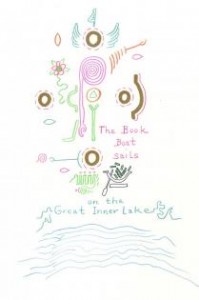 Long a hub for hearing the poetry and poetic voices of the now, New York City next week and the week after hosts some of the best poetry events and exhibitions happening during this National Poetry Month.
Long a hub for hearing the poetry and poetic voices of the now, New York City next week and the week after hosts some of the best poetry events and exhibitions happening during this National Poetry Month.
On Tuesday, April 14, the prolific and prize-winning poet Alice Notley will read her work at the City University of New York Center for the Humanities. Erica Kaufman, editor of the ever-fresh and propitious Lost & Found publication series, an initiative of the CUNY Center for the Humanities, will lead a conversation with Notley during the program.
While you are in the City, see the rarely exhibited notebooks and drawings of the poet, musician, activist Ed Sanders on display at the Poet’s House, located on its serene perch at 10 River Terrace. During the course of a long and diverse career Sanders used a glyphic alphabet, a script of hand-drawn characters, symbols, and graphemes. In his words, “a Glyph is a drawing that is charged with literary, emotional, historical or mythic, and poetic intensity.” Curated by Ammiel Alcalay and Kendra Sullivan, the show displays pictures and manuscripts by Sanders from 1962 to the present.
On Thursday, April 23, Pulitzer Prize-winner Sharon Olds, and Bob Holman, founder of the Bowery Poetry Café, will sit in a booth (inspired by Lucy’s booth from the Peanuts comic strip) and write poems for those who request one. The Poet is In: takes place in the new Fulton Street Station and features an array of award-winning poets, including NY State Poet Laureate Marie Howe. Free and open to the public, 11 a.m. to 6 p.m.

